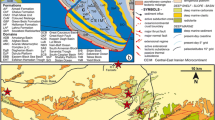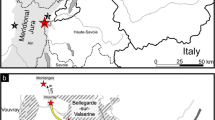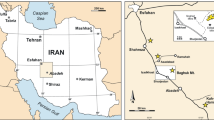Abstract
The Global Stratotype Section and Point (GSSP) for the Permian-Triassic boundary was placed in Bed 27 of Meishan section D where the conodont species Hindeodus parvus first occurs. Bed 27 was usually considered comprising continuously-deposited, homogeneous silty limestone, with no depositional hiatus near the boundary. Detailed study on the boundary sequence revealed that a typical firmground characterized by Glossifungites ichnofacies developed about 2 cm below the Permian-Triassic boundary in Bed 27. Fossil content and lithology show apparent differences across the firmground crust. The abundance of the Permian bioclasts decreases significantly across the firmground, and is accompanied by a shift of dominating carbonate precipitation from calcite to dolomite. The firmground marked a rapid transgression at the very end of the Late Permian and significant shifts of sedimentary environment and paleoclimate. This transgressive submerging surface is also observed at the Huangzhishan section of the shallow-water carbonate platform facies in Zhejiang Province, the Jiangya section of the lower-slope to basinal-margin facies in Hunan Province, the Pingdingshan section of the basinal facies in Anhui Province of South China, as well as the Selong section in Tibet of the northern peri-Gondwana. The transgressive submerging surface marks the onset of a rapid global transgression at the latest Permian.
Similar content being viewed by others
References
Yin H F, Zhang K X, Tong J N, et al. The Global Stratotype Section and Point (GSSP) of the Permian-Triassic boundary. Episodes, 2001, 24: 102–114
Cao C Q, Shang Q H. Microstratigraphy of Permo-Triassic transitional sequence of the Meishan section, Zhejiang, China. Palaeoworld, 1998, 9: 147–152
Zheng Q F. Sedimentary microfacies and sequence stratigraphy of the P-T boundary beds of the Meishan section, Changxing Country, Zhejiang (in Chinese). J Stratigr, 2006, 30: 373–383
Cao C Q, Zheng Q F. Geological event sequences of the Permian-Triassic transition recorded in the microfacies in Meishan section. Sci China Ser D-Earth Sci, 2009, 52: 1529–1536
Yin H F, Wu S B, Ding M H, et al. The Meishan section, candidate of the globle stratotype section and point of Permian-Triassic boundary. In: Yin H F, ed, The Palaeozoic-Mesozoic Boundary, Candidate of the Globle Stratotype Section and Point of Permian-Triassic Boundary. Wuhan: China University of Geosciences Press, 1996. 31–48
Sheng J Z, Chen C Z, Wang Y G, et al. Permian-Triassic boundary in middle and eastern Tethys. J Fac Sci Hokkaido U, 1984, 21: 133–181
Yang W R, Jiang N Y. On the depositional characters and microfacies of the Changhsing Formation and Permian-Triassic boundary in Changxing, Zhejiang (in Chinese). Bull Nanjing Inst Geol Palaeontol, CAS, 1981, 2: 113–131
He J W. Clay minerals in the Changhsingian stratotype section and the basal part of Yinkeng Formation, with reference to the Permo-Triassic boundary (in Chinese). J Stratigr, 1981, 5: 197–206
He J W, Rui L, Chai Z F, et al. The latest Permian and earliest Triassic volcanic activities in the Meishan area of Changxing, Zhejiang (in Chinese). J Stratigr, 1987, 11: 194–199
Zhang K X, Tong J N, Shi G R, et al. Early Triassic conodont-palynological biostratigraphy of the Meishan D Section in Changxing, Zhejiang Province, South China. Palaeogeogr Palaeoclimatol Palaeoecol, 2007, 252: 4–23
Jiang H S, Lai X L, Luo G M, et al. Restudy of conodont zonation and evolution across the P/T boundary at Meishan section, Changxing, Zhejiang, China. Global Planet Change, 2007, 55: 39–55
Feng Z Z, He Y B, Wu S H, et al. Study of Lithofacies Paleogeography of Qinglong Group of Lower-Middle Triassic in the Lower Yangtze River Region (in Chinese). Kunming: Yunnan Science & Technology Press, 1988. 1–197
Feng Z Z, Wang Y H, Li S W, et al. Lithofacies Paleogeography of Permian of Middle and Lower Yangtze Rigion (in Chinese). Beijing: Geological Publishing House, 1991. 1–282
Wang Y, Jin Y G. Permian palaeogeographic evolution of the Jiangnan Basin, South China. Palaeogeogr Palaeoclimatol Palaeoecol, 2000, 160: 35–44
Wignall P B, Hallam A. Griesbachian (Earliest Triassic) palaeoenvironmental changes in the Salt Range, Pakistan and southeast China and their bearing in the Permo-Triassic extinction. Palaeogeogr Palaeoclimatol Palaeoecol, 1993, 102: 215–237
Yin H F, Huang S J, Zhang K X, et al. The effects of volcanism on the Permo-Triassic mass extinction in South China. In: Sweet W C, Yang Z Y, Dickins J M, et al., eds. Permo-Triassic Events in the Eastern Tethys: Stratigraphy, Classification, and Relations with the Western Tethys. Cambridge: Cambridge University Press, 1992. 146–157
Shen W J, Lin Y T, Xu L, et al. Pyrite framboids in the Permian-Triassic boundary section at Meishan, China: Evidence for dysoxic deposition. Palaeogeogr Palaeoclimatol Palaeoecol, 2007, 253: 323–331
Chai Z F, Zhou Y Q, Mao X Y, et al. Geochemical constraints on the Permo-Triassic boundary event in South China. In: Sweet W C, Yang Z Y, Dickins J M, et al., eds. Permo-Triassic Events in the Eastern Tethys: Stratigraphy, Classification, and Relations with the Western Tethys. Cambridge: Cambridge University Press, 1992. 158–168
Cao C Q. Carbon isotope excursions across the Permian-Triassic transition at Meishan section (in Chinese). Report of Postdoctoral Research. Nanjing: Nanjing Institute of Geology and Palaeontology, Chinese Academy of Sciences, 2003. 1–98
Yang Z Y, Wu S B, Yin H F, et al. Permo-Triassic Events of South China (in Chinese). Beijing: Geological Publishing House, 1993. 1–153
Clark D L, Wang C Y, Orth C J, et al. Conodont survival and low iridium abundance across the Permian-Triassic boundary in South China. Science, 1986, 223: 984–986
Clari P A, Pierre F Dela, Martire L. Discontinuities in carbonate successions: Identification, interpretation and classification of some Italian examples. Sediment Geol, 1995, 100: 97–121
Tong J N, Zuo J X, Zhao L S, et al. Study on the lower Triassic of Chaohu, Anhui Province. In: Editorial Committee of Professional Papers of Stratigraphy and Palaeontology, Chinese Academy of Geological Sciences, eds. Professional Papers of Stratigraphy and Palaeontology (in Chinese). Beijing: Geological Publishing House, 2004. 28: 147–163
Peng Y Q, Tong J N, Shi G R, et al. The Permian-Triassic boundary set: Characteristics and correlation. Newsl Stratigr, 2001, 39: 55–71
Tong J N, Yin H F, Zhang J J, et al. Proposed new Lower Triassic stages in South China. Sci China Ser D-Earth Sci, 2001, 44: 961–967
Chen J, Henderson C M, Shen S Z. Conodont succession around the Permian-Triassic boundary at the Huangzhishan section, Zhejiang and its stratigraphic correlation. Acta Palaeontol Sin, 2008, 47: 91–114
Orchard M J, Nassichuk W W, Lin R. Conodonts from the lower Griesbachian Otoceras latilobatum bed of Selong, Tibet and the position of the Permian-Triassic boundary. In: Embry A F, Beauchamp B, Glass D J, eds. Pangea: Global Environments and Resources. Can Soc Petrol Geol Mem, 1994, 17: 823–843
Jin Y G, Shen S Z, Zhu Z L, et al. The Selong Section, the candidate of the Global Stratotype Section and Point of the Permian-Triassic boundary. In: Yin H F, ed. The Palaeozoic-Mesozoic Boundary, Candidates of the Global Stratotype Section and Point of the Permian-Triassic Boundary. Wuhan: China University of Geosciences Press, 1996. 127–137
Mayer L A, Shipley T H, Winterer E L. Equatorial pacific seismic reflectors as indicators of global oceanographic events. Science, 1986, 233: 761–764
Keller G, Herbert T, Dorsey R, et al. Global distribution of late Paleogene hiatuses. Geology, 1987, 15: 199–203
Jenkyns H C. The genesis of condensed sequences in the tethyan Jurassic. Lethaia, 1971, 4: 327–352
Pinet P R, Popenoe P. A scenario of Mesozoic-Cenozoic ocean circulation over the Blake Plateau and its environs. Geol Soc Am Bull, 1985, 96: 618–626
Mullins H T, Gardulski A F, Hinchey E J, et al. The modern carbonate ramp slope of central West Florida. J Sediment Petrol, 1988, 58: 273–290
Ramsay A T S, Sykes T G S, Kidd R B. Sedimentary hiatuses as indicators of fluctuating oceanic water masses: A new model. J Geol Soc, 1994, 151: 737–740
Farinacci A, Malantrucco G, Mariotti N, et al. Ammonitico Rosso facies in the framework of the Martani mountains paleoenvironmental evolution during Jurassic. In: Farinacci A, Elmi S, eds. Rosso Ammonitico Symposium Proceedings, 1981. 311–334
Vera J A, Ruiz-Ortiz P A, Garcia-Hernandez M, et al. Paleokarst and related pelagic sediments in the Jurassic of the Subbetic Zone, Southern Spain. In: James N P, Choquette P W, eds. Paleokarst. New York: Springer-Verlag, 1988. 364–384
Alvarez W, Colacicchi R, Montanari A. Synsedimentary slides and bedding formation in Apennine pelagic limestones. J Sediment Petrol, 1985, 55: 720–734
Coniglio M. Synsedimentary submarine slope failure and tectonic deformation in deep-water carbonates, Cow Head Group, western Newfoundland. Can J Earth Sci, 1986, 23: 476–490
Eren M, Tashi K. Kilop Cretaceous hardground (Kale, Gümüshane, NE Turkey): Description and origin. J Asian Earth Sci, 2002, 20: 433–448
Obrochta S P, Duncan D S, Brooks G R. Hardbottom development and significance to the sediment-starved west-central Florida inner continental shelf. Mar Geol, 2003, 200: 291–306
Shen S Z, Crowley J L, Wang Y, et al. Calibrating the end-Permian mass extinction. Science, 2011, 334: 1367–1372
Author information
Authors and Affiliations
Corresponding author
Rights and permissions
About this article
Cite this article
Zheng, Q., Cao, C. & Zhang, M. Sedimentary features of the Permian-Triassic boundary sequence of the Meishan section in Changxing County, Zhejiang Province. Sci. China Earth Sci. 56, 956–969 (2013). https://doi.org/10.1007/s11430-013-4602-9
Received:
Accepted:
Published:
Issue Date:
DOI: https://doi.org/10.1007/s11430-013-4602-9




